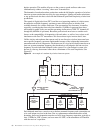
88 Handbook of Intercom Systems Engineering
duplex operation. This enables all users on the system to speak and hear other users
simultaneously without “covering” other users’ transmissions.
The demands of modern broadcast productions make the full-duplex operation of wireless
intercom systems an absolute necessity for stage managers, lighting and audio technicians,
or any professional who has to deal with the breakneck speed and complexity of television
productions.
The spread of digital television (DTV) and the ever-increasing number of wireless users
has made the available frequency spectrum a more difficult place in which to find
available channels for wireless intercoms. The spectrum has also become a lot smaller,
especially considering that four television channels (24 MHz of spectrum) have been
reallocated for public safety use and the upcoming reallocation of UHF TV channels 60
through 69 (60 MHz of spectrum). Broadcast professionals now have to consider such
factors as the compatibility of frequencies with each other, as well as, how to best avoid
interference with local TV transmitters. We discuss these topics in more detail, later.
Unlike wireless microphones that operate only in one direction, wireless intercoms have
more specific frequency spectrum requirements because of the relationship between the
transmitter and receiver frequencies. Each intercom (if it is to be full-duplex) must have at
least one system transmitter frequency that broadcasts to all beltpacks and one receiver
frequency for each individual beltpack in the system. For a four beltpack system, also
known as a four up, that means it must have a minimum of five total frequencies. See
Figure 6.2.
Figure 6.2
An example of a modern day wireless intercom system.
Each beltpack must have a receiver set to the base transmit frequency and a transmitter set
to its own unique receiver in the base. Due to a phenomenon mentioned earlier called
desensing, these two frequencies must have a fairly large frequency separation, typically at
least 12 MHz for VHF systems, and even more for UHF, or the transmitter will interfere
with the receiver’s operation.
RECEIVER &
TRANSMITTER
FOR
WALK
AROUND
1
COMMONTX
FOR ALL
WALK AROUND
PACKS
RX
FOR
WALK
AROUND
1
RX
FOR
WALK
AROUND
2
RX
FOR
WALK
AROUND
3
RX
FOR
WALK
AROUND
4
ANTENNA SPLITTER
RECEIVER
ANTENNA FROM
WALK AROUNDTX’S
TRANSMIT ANTENNA
TO ALL
WALK AROUND RX’S
23
4


















